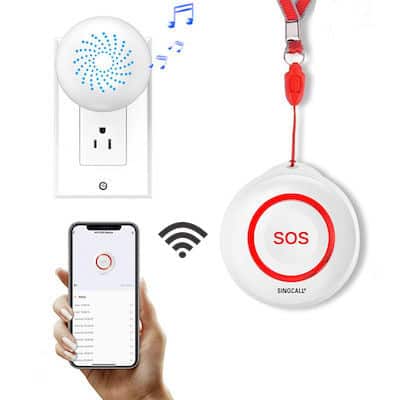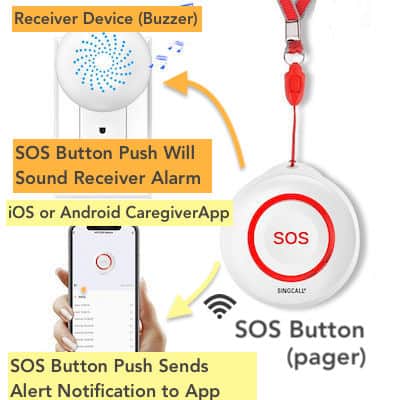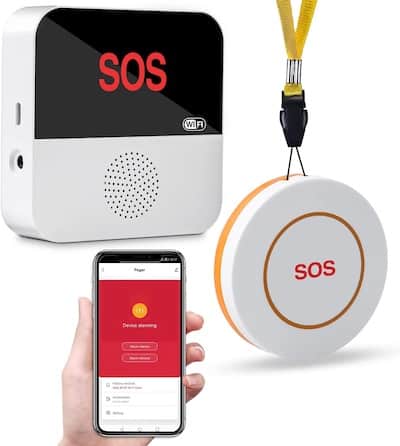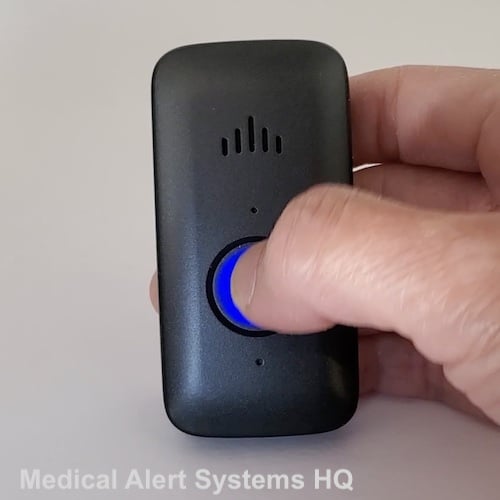Last Updated on March 21, 2023
With the rapid growth of broadband internet and the use of mobile devices, more and more homes these days have wifi networks installed.
According to Pew research, 64% of seniors 65+ have broadband access at home. According to an AARP 2023 research, 86% of adults 50+ own a smartphone. Most of us are used to retrieving messages and alerts from our smartphones daily.
When you consider these two aspects, it is no wonder that many seniors and their children are looking into a wifi medical alert system rather than a landline life alert system.
Wifi SOS Emergency Alert Systems
Wifi-based emergency alert systems will pair an SOS transmitter button to a wifi network. The senior product user can push on their SOS button (also known as a panic or call button) to send an alert through wifi to the internet.
Notifications Through Linked App
To receive the alert notification sent via wifi, family members and caregivers must install the product’s app and link with their elder’s button. The SOS alert process works through the wifi and internet connectivity of the home where the senior product user resides.
SOS Button Within Range of Home Wifi
The alarm process will not work if the SOS transmitter is outside the range of the home wifi network. However, the smartphone with the installed app can be connecting through any wifi network or its mobile data plan. It does not need to be on the home wifi network.
This will be clearer when we go through a few examples of the best wifi alert systems on the market.
Best Wifi and Wireless Alert Systems
SingCall Wifi Smart Wireless Caregiver Pager System
Pros
- Button sends smartphone alert through home wifi network. No home phone line is needed.
- Family and caregivers can receive notifications away from home.
- In-home receiver alarm can be triggered even if wifi is down.
- In-home receiver (buzzer device) will both light-up and sound.
- Low cost, no monthly fees to worry about.
Cons
- SOS button works at home only. Must be able to sync up with home wifi to send alert to smartphone.
- Uses a 2.4 Ghz wifi band only. Some newer routers are 5 Ghz only, so this could be technically challenging.
- No two-way communication.
- No monitoring provided. The onus is on family members and caregivers to watch out for the alert and respond.
- No backup battery supply in case of power outages.
If you like an easy and direct way for a senior loved one to buzz for help, the SingCall Smart Wireless Caregiver Pager system is worth checking out. After testing out the product, we were impressed by what it can do despite its low cost and lack of subscription fees.
There are 3 parts to the SingCall Wifi Smart Wireless Caregiver Pager system:
- A round-shaped SOS button a little over 2 inches in diameter. This is the button that our parents or elder keeps on them. It’s large and easy to press.
- A larger spherical receiver device that sounded when we pushed on the SOS button. We plugged the device into an electrical outlet. The SOS button acts like a wireless remote control. It sounds an alarm on the receiver device by radio frequency, not wifi.
- We installed the product’s app (Tuya app) on our smartphone and then linked it to the SOS button through our wifi network. Upon pushing the SOS button, the notification came through.
How It Works
This simple medical alert system is ideal for situations where the family or caregivers are close to the elder. An alarm is triggered in two ways:
When the SOS button is pushed, it will wirelessly transmit a signal to the spherical receiver or buzzer device to play a loud musical tune. What’s great is that this receiver device comes with 4 volume settings. The loudest is calibrated to be 120 decibels, which is intense – louder than a stereo playing at high volume.
At the same time, the SOS button will also send an alarm signal via wifi through to the smartphone app. This will show up as an alert to the app, and with the smartphone notification permissions, it would appear as an alert notification for the app on your smartphone.
Daily Care Alerts
These alerts are not limited to just severe medical emergencies requiring first responders. They are often used for regular caregiving, such as helping our elder to bed or the bathroom. This set-up of a call button and receiver/buzzer is sometimes referred to as a nurse call system.
Stable 2.4 Ghz Internet Connection Required
You would need a stable internet and wifi connection at the 2.4 Ghz band. If the internet or wifi is down, the system will not work. This could affect product performance in areas where internet connectivity is less stable. Some product users also reported difficulties changing to or adding a 2.4 Ghz band to their wifi set-up.
What mitigates the situation is that the SOS button and the receiver (loud buzzer) pairing does not require wifi. If the internet or wifi fails, the receiver or buzzer part of the system is not affected.
No Alerts During Power Outage
Unfortunately, if your home loses power during a storm or other situations, then the SOS button will not be able to successfully alarm any device; whether it’s the receiver or your cell phone. To address this, you could explore backup power source options.
A more straightforward solution may be to use a cellular mobile medical alert device like the LifeFone VIPx. It offers up to 16 days of backup battery life and works both in and outside the home.
Overall
Overall, the SingCall wifi Smart Wireless emergency alert system is a viable option for sending alerts through wifi. It allows family members or caregivers to receive alerts even when away from home. A significant plus is that the in-home receiver does not require wifi or the internet to sound.
This is a good wifi-based system as long as you are OK with its drawbacks as discussed above. Unlike a Life Alert system, there are no monthly fees and the product cost is hard to beat. Plus, it has received much good user feedback for how well it works.
Kinglead Wireless Wifi Caregiver Pager
The Kinglead Wireless wifi Caregiver pager system is another wifi-based emergency alert system. Similar to the SingCall system above, there are three parts to this wireless system:
- A round-shaped SOS button that will send alarms through wifi to a receiver device and a smartphone app.
- A rectangular receiver (or buzzer) device that needs to be plugged into the included USB cable.
- A Tuya smartphone app downloaded on a caregiver’s phone is linked to the SOS button. Both the receiver device and the call button are linked through the app.
Comparison with SingCall System above
The Kinglead wifi alert system works very much like the SingCall product reviewed above. Like the SingCall Wifi system, it will work only on a 2.4 Ghz wifi band. Most of the same advantages and disadvantages listed above applies, except for the following difference.
The main difference between this system (Kinglead) and the first one (SingCall) is that with this Kinglead system, the SOS button sends alerts through wifi only. So if the internet or wifi is down, no alarms will sound.
With the SingCall system, even if wifi does not work, the in-home receiver can still sound and alert someone. Like a remote control, their SOS button directly activates their in-home receiver alarm. No wifi is needed.
There is greater operational reliability that way.
Furthermore, the SingCall in-home receiver device conveniently plugs into a wall outlet. It’s hassle-free to install. The Kinglead system’s receiver requires an awkward USB cable, and you still need to screw or stick it to the wall.
We value the Singcall system’s enhancements in reliability and design, and thus prefer it over the Kinglead system.
Overall
In general, the Kinglead wifi caregiver alert system works as described. It is ideal for seniors who want an easy way to summon help from a nearby family member or caregiver. It has attracted great customer feedback and requires no monthly fees. These positives should be weighed against limitations like having no monitoring or backup battery.
LifeFone VIPx Wireless Medical Alert Device
Pros
- One-click to call. 24/7 monitoring center, trained agent will always answer.
- Two-way communication. Speaker and microphone on device.
- No home phone or cellular phone line needed.
- Works at home and away from home.
- Designated relatives or caregivers can receive text and email alerts.
- GPS tracking. Device location information is available through optional caregiver app.
- Backup battery life (up to 16 days).
Cons
- Will only work if the cellular network signals are strong enough.
- Monthly cost.
The LifeFone VIPx system is an excellent option for caregivers who want more than a simple in-home alert system. The LifeFone VIPx wireless medical alert device works at home and away from home. The device comes with a speaker and microphone, so seniors can speak into their device and ask for help. A live agent from a certified monitoring service will answer the call.
LifeFone is a long-established medical alert service provider with decades of experience. This product overcomes some of the drawbacks of the wifi emergency alert systems reviewed above.
This device offers some premium features, but it is also more costly, and the alerts sent will involve an outside monitoring service.
How to Get Help
To get help, our senior relative can push on the device’s button. The monitoring center agent will speak with our senior and determine the best way to assist them. For example, they could call on emergency services or a care contact to help the senior, or both.
The use of the VIPx device is not limited to your home only. The product does not depend on any home phone or wifi connection. Instead, it works through an included cellular phone service plan.
It comes equipped with GPS receivers. So if an alert is activated, it ensures that we can always get a GPS reading of where our elder is. This can be an important safety feature for seniors whose memory is deteriorating.
Comparison with Wifi-Based Emergency Alert Systems
While the LifeFone VIPx is a wireless medical alert, it does not depend on wifi. Compared to the above wifi systems by SingCall and Kinglead, the LifeFone VIPx product does not require you to fiddle with syncing a device to your wifi.
Ease of Set-Up
The LifeFone VIPx system was easier to set-up than the SingCall or Kinglead wifi medical alert products. After charging the device up, we placed a phone call to the company. A support representative guided us through to our first test button push.
Monitoring
LifeFone VIPx also comes with 24/7 monitoring, meaning someone will always answer the call. It is similar to a traditional life alert system, but with the benefit of working both at home and away from home. If there’s a power outage, the device can continue functioning on its device battery (up to 16 days on backup).
More Suited for Serious Emergencies
Compared to the SingCall and Kinglead systems, the LifeFone VIPx serves better as an alarm system for more serious emergencies. This is because it is a monitored system. So you can rest assured that someone will always answer the alert call. In addition, compared to wifi-only systems, it is less subject to the vagaries of the internet going down or power outages.
That said, the LifeFone VIPx may be an overkill if you are looking for a button to alert someone nearby frequently. With a wifi-enabled system, you push the button to sound an alert, and a nearby family member or caregiver is supposed to come check on you.
You may not need the alert to go through a “middle-man” operator, like what LifeFone or Life Alert offers. There are different types of personal safety products.
Overall
The LifeFone VIPx is best recommended if you prefer a premium wireless medical alert. The VIPx comes with 24/7 monitoring and the ability to work both at home and away from home. There’s also GPS tracking and an optional caregiver app for retrieving GPS information.
Special Offer: Get 1 Free Month, Free Activation, Free Shipping & Price Lock Guarantee. With annual/ quarterly payment plans. No promo code needed, Call today 1-877-352-1292.
Disclosure: We receive referral commissions for purchases made (details).
Wifi Medical Alert Frequently Asked Questions (FAQs)
Do medical alert systems require the internet or wifi?
No. In general, medical alert systems do not require the use of the internet or wifi. Instead, they use a cellular connection. The cellular phone service comes bundled with the product. It is dedicated to making emergency calls only. Even if you have a cell phone plan, the medical alert product’s connectivity works independently from your cell phone line, which is a good safety feature.
Are there emergency alert systems that use wifi?
Yes, there are emergency alert systems that work through wifi. They come with an SOS transmitter button that is paired to a caregiver app. When pushed, the SOS button will send an alert through wifi. The caregiver’s smartphone will receive a notification alert through the companion app. There is no two-way communication with this system. These products are similar to caregiver or nurse call systems.
Many homes no longer have a home phone line. As such, people are seeking systems that work through wifi and the internet instead. We’ve included reviews of the best wifi or wireless medical alert systems for you to compare their pros and cons.
In a hurry? Leave us your email, we’ll follow-up with the best tips.






